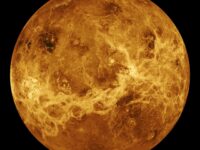Early in its discovery, Venus was thought to have a similar atmosphere to Earth’s for reasons such as observed clouds, but upon researching the environment of Venus, it became obvious that the climate was far from Earth’s. The temperature on a normal day is around 400 degrees Celsius, or 752 degrees Fahrenheit, and its surface pressure is one hundred the times the pressure on Earth. Suffice to say that the prospect of life on such a hellish planet was thought to be pretty small. Despite this, recent studies have shown that, while its appearance seems unsuitable to life, there is data supporting the notion that, at one point, Venus was inhabitable and possibly had life of its own.
“While its appearance seems unsuitable to life, there is data supporting the notion that, at one point, Venus was inhabitable and possibly had life of its own.”
One study published by the American Astronomical Society proposed that Venus could have had a climate similar to Earth until relatively recently. Researchers noticed how Venus currently has the lowest orbital eccentricity in the solar system, meaning the variability in its orbit is particularly low compared to nearby planets, and they were able to determine, by comparing various models, that the eccentricity was likely affected by Jupiter’s migrations within the solar system. Orbital eccentricity is important for evolution as it plays a large part in tidal energy and insolation flux, both of which contribute to maintaining stable heat, protecting against greenhouse effects, and prohibiting extreme water loss. This means that the migration of Jupiter within its orbit might have limited the orbital eccentricity of Venus, causing it to experience a rapid loss of water and enter a greenhouse state within its atmosphere. While this theory relies on some assumptions, such as implying there was water on Venus at one point without any evidence, it shows that the surface of Venus could have had a much more inhabitable terrain within the relative history of our solar system.
“They made the correlation between this 40-year-old reading and a possible sign of microbial alien life.”
Despite its surface now being uninhabitable, researchers have found evidence that life may exist somewhere else on Venus — in the clouds. For nearly 40 years, a reading of phosphine gas within the clouds of Venus went largely unnoticed, as at the time, phosphorus-related gasses were largely ignored in the quest for finding life. But in September of 2020, a team of researchers from the University of California Riverside revealed in Nature Astronomy that they made the correlation between this 40-year-old reading and a possible sign of microbial alien life. While research following this discovery is still in its preliminary stages, the team has also found hints of other chemicals that predict signs of life such as oxygen, chlorine, and hydrogen peroxide.
“The spectral signatures of Venus, reconfirming a great deal of what was already known about the planet but also denoting something new.”
To fully investigate this lead would take much more research, but the presence of these chemicals is not the only evidence as to why Venus’s clouds are possible locations for life. Venus’s lowest cloud has a climate in stark contrast to its surface, with temperatures of 60 degrees Celsius, or 140 degrees Fahrenheit, and 1 atmosphere of pressure, both of which are much more suitable to life. One study done by the University of Wisconsin published in Astrobiology in 2018 investigated the spectral signatures of Venus, reconfirming a great deal of what was already known about the planet but also denoting something new. In addition to studying its heavily sulfuric atmosphere, researchers noted that measured ultraviolet (UV) radiation resembles UV levels present when Archean Earth held photosynthetic life. This led to the conclusion that UV radiation absorption in their readings could very well be indicative of some sort of photosynthetic microorganism.
While the surface of Venus appears to be one of the most uninhabitable locations in the solar system, current research regarding its history and current atmosphere provides sufficient reasoning for further investigation into life on Venus. If given the same level of attention as Mars, perhaps it will become apparent that Earth was investigating the wrong neighbor for life.
Astrobiology (2018). DOI: 10.1089/ast.2017.1783
The Planetary Science Journal (2020). DOI: 10.3847/PSJ/abae63

